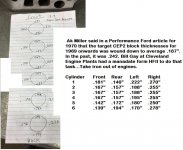The Clifford shop built 250 with an .070 overbore
CZLN6 mentions is in my '61 Comet
. NA Tri-Power setup uses fairly mild SCR of @ 9.5 with the AMC 258 3.75" pistons
. The engine has all ARP fasteners, Balanced Shot Peened rods, custom balancer and a few other internal block mods and extensive head work.
Anecdotally: Has run great for over ten years without 'coddling' and occasional serial strip launches over 5K rpm .
Also
anecdotally: Current small block six project is a Maverick 250 with a Vortech VII Supercharger. Stock block and cam with the head simply
freshened but
not milled yields @ 8.7:1 SCR with composite gasket. Pproject evolved from a Buick derived Turbocharger on the original 250 in the Maverick. With the
T3/Draw-thru/Quadjet BOP setup, boosted incrementally until the piston lands broke off at @ 20PSI of boost. Current 250 SC blo-thru setup uses stock 250 internals with the
freshened head and I keep boost to @ 10PSI with occasional runs to @ 15lbs. Uses' modified
(inexpensive) Holley 2300-7448 350cfm carb with a BRPV operating with boost. Modified DSII ignition advance is controlled to @ 26 degrees max' and stock exhaust with sensor for mandatory AFR gauge (closely monitored) has kept detonation destruction at bay. Street use for past two years has yielded impressive performance with no problems.
"Your mileage may vary"...
250 / Draw-Thru BOP TC setup

.

.

.

250/VII SC

.

.

.
have fun
250 CID inline Small Block Six - . Stock block and cam with 60 cc chamber head, V8 valve springs, ARP head bolts. Holley 2300 - 7448 2Bbl modified for blow-through/ boost, Aeromotive 1:1 boost referenced regulator and FI electric pump with return at tank. Flame Thrower rev-limited HEI ignition - DS II distributor modified for vac and centrifugal boost advance limiting. Vortech V-2 centrifugal supercharger with pulley ratio spec’d for inline six 250' powerband. Centerforce weighted clutch, T5-Z 'Cobra' 5 Speed, 3.80 rear. AM radio and bench seat.
 .
. 











